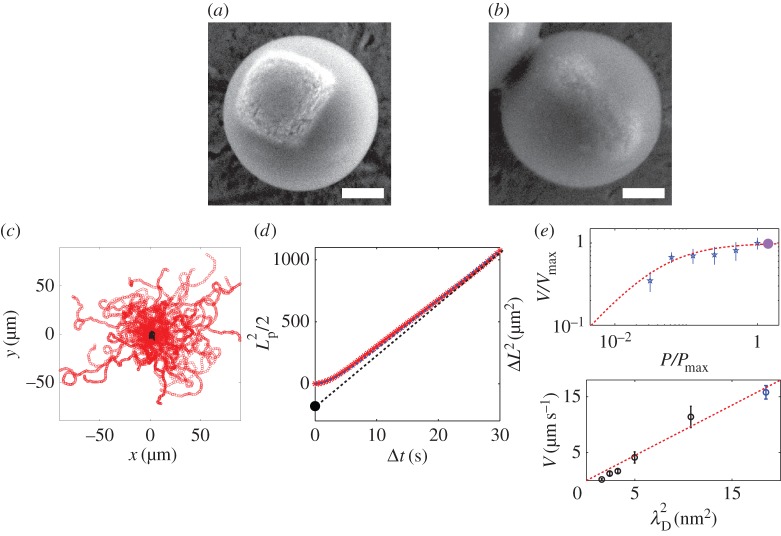Figure 4.
(a,b) A diverse family of colloidal surfers. (a) SEM picture of large haematite cube embedded in a spherical TPM shell. (b) SEM picture of ellipsoid haematite embedded in a TPM shell. (c) Superimposition of many trajectories of the colloidal surfers light off (black) and light on (red). The trajectories are started at position (0, 0). The self-propulsion is isotropic and the dynamics is a persistent random walk. The particles self-propel at a given velocity V which direction is randomized by thermal fluctuations, over a timescale τr. (d) Mean square displacement (MSD) ΔL2 averaged for a dozen particles (red symbols). The MSD is well described by a persistent random-walk dynamics (equation (2.3), blue dashed line). For short times, t≪τr, the trajectory is ballistic and ΔL2∝Δt2. The self-propelled particles exhibit an enhanced effective diffusion at long times ΔL2∝4DeffΔt. The extrapolation of the enhanced diffusion regime allows an alternate determination of the persistent length of the motion (equation (2.4), black dashed line). (e) Self-propulsion velocity of haematite composite surfers as a function of the light intensity. Blue symbols for activation by blue (430–490 nm) light, and full violet circle for activation by the UVA-violet (370–410 nm) light. The red dashed line is a fit of the experimental data by a Michaelis–Menten kinetics, typical of enzyme catalysis. (f) Self-propulsion velocity as a function of the Debye length of the solution, varied by addition of sodium chloride salt (black symbols) and withdrawing of the SDS surfactant in the solution (blue symbol). The experimental results agree with  (red dashed line), expected for phoretic interfacial transport, stressing the role of electrostatics in the system. (Online version in colour.)
(red dashed line), expected for phoretic interfacial transport, stressing the role of electrostatics in the system. (Online version in colour.)

